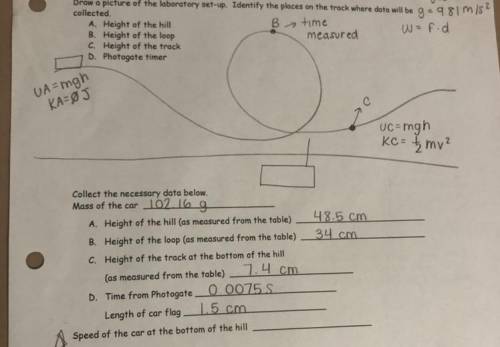
1) what is the potential energy at the end of the loop?
2)what is the kinetic energy at the end of the loop(based upon photogate time?
release the car and record the time from the photogate at the bottom of the hill and answer the top questions:
i attached an image that shows the recorded time


Answers: 3
Other questions on the subject: Physics

Physics, 22.06.2019 09:30, ryanmorse01
The necleus of an atom is made up of what subatomic particles?
Answers: 1

Physics, 22.06.2019 15:40, winterblanco
Question 1 what is amperage? is the rate of doing work. is the rate of flow of protons in electric current. represents the amount of pressure behind electron flow. is the rate of flow of electrons in electric current. 2 points question 2 what is voltage? is the rate of doing power. represents the amount of pressure behind electron flow. is the rate of doing work. is the rate of flow of electrons in electric current. 2 points question 3 what is power? is the rate of flow of protons in electric current. is the rate of flow of electrons in electric current. is the rate of doing work. represents the amount of pressure behind electron flow. 2 points question 4 if we multiply volts times amps we get what? power circuit work current 2 points question 5 what are two ways alternating currents are similiar? in both ac and dc electrons flow in the same pattern. in both ac and dc, the flow of electrons changes directions back and forth. both ac and dc are only possible in certain materials with atoms that will allow electron flow. both ac and dc involve the flow of electrons. 4 points question 6 how does the flow of electrons flow in an alternating current? the flow of electrons is always slower in an alternating current than within a direct current. the flow of electrons is not constant and forward; it changes direction back and forth. electrons flow from from a higher affinity to that of a lower affinity. electron flow is constant and only in a forward direction. 2 points question 7 what is the flow like in a direct current? the flow of electrons is not constant and forward; it changes direction back and forth. the flow of electrons is constant and only in a forward direction. the flow of electrons go from a higher affinity to a lower affinity. the flow of electrons are always faster in a direct current. 2 points question 8 how is an electric current able to flow? electrons flow from the higher affinity to lower affinity and electrical current is generated. protons flow from the higher affinity to lower affinity and electrical current is generated. the movement of protons from one atom to another leads to an electric charge. the movement of electrons from one atom to another atom in a line results in a flow of electric current. 2 points question 9 how do electrons move from the two different types of metal in a battery? protons flow from the metal with the lower affinity to the metal with higher affinity and electrical current is generated. electrons flow from the metal with the lower affinity to the metal with higher affinity and electrical current is generated. electrons flow from the metal with the higher affinity to the metal with lower affinity and electrical current is generated. protons flow from the metal with the higher affinity to the metal with lower affinity and electrical current is generated.
Answers: 2

Physics, 22.06.2019 21:00, estebencampos69
Aflask with vinegar in it has a mass of 160 grams. a balloon with baking soda in it has a mass of 40 grams. the balloon is attached to the flask to seal the opening and the vinegar and baking soda mixes. the balloon inflates to a large volume. what will the total mass of the balloon and flask be after the balloon inflates? explain. a) less than 200 grams because the solid baking soda disappears. b) 200 grams, because all the atoms remain in the balloon or flask. c) more than 200 grams because the size of the balloon is so much larger. d) less than 200 grams because gases such as the one in the balloon are lighter than solids and liquids.
Answers: 1

Physics, 22.06.2019 22:30, josephaciaful
Determine the net charge of the predominant form of arg at (a) ph 1.0, (b) ph 5.0, (c) ph 10.5, and (d) ph 13.5
Answers: 2
Do you know the correct answer?
1) what is the potential energy at the end of the loop?
2)what is the kinetic energy at the end of...
Questions in other subjects:

Social Studies, 02.10.2021 14:00

History, 02.10.2021 14:00

SAT, 02.10.2021 14:00



Mathematics, 02.10.2021 14:00

Biology, 02.10.2021 14:00


Mathematics, 02.10.2021 14:00

Biology, 02.10.2021 14:00






